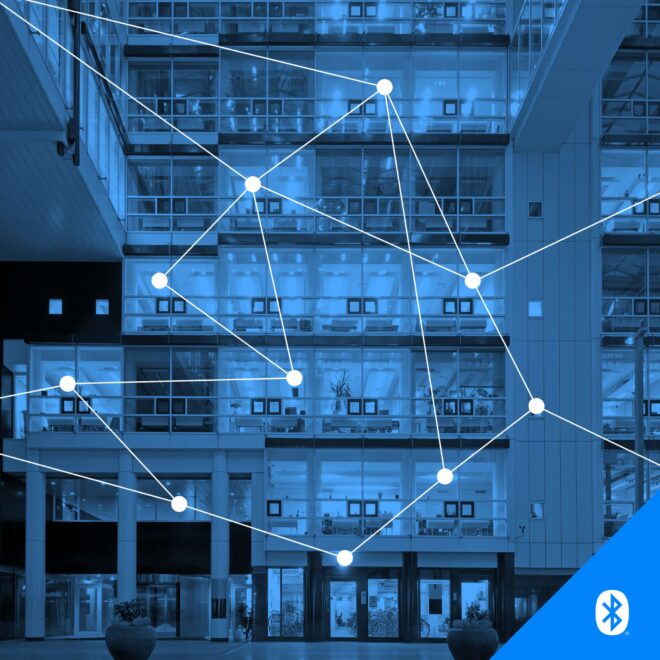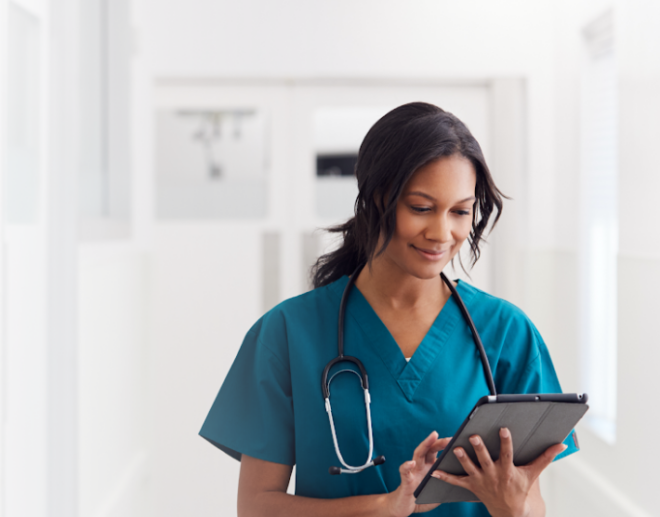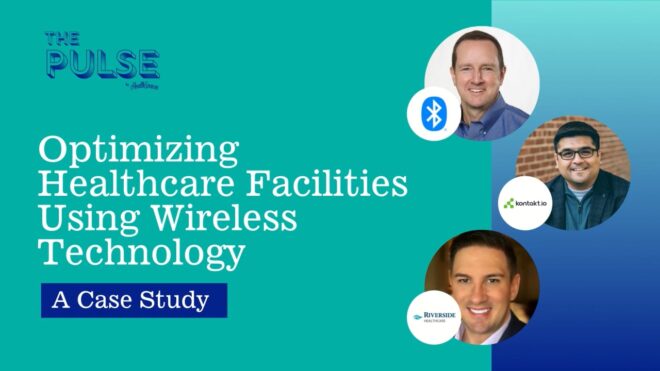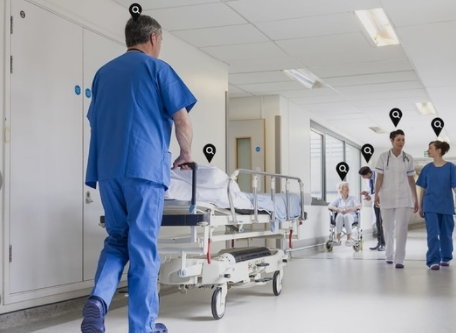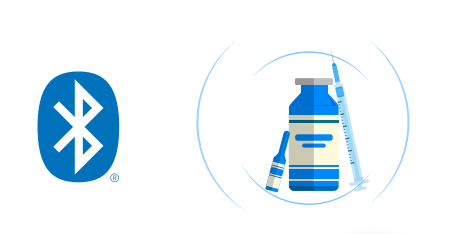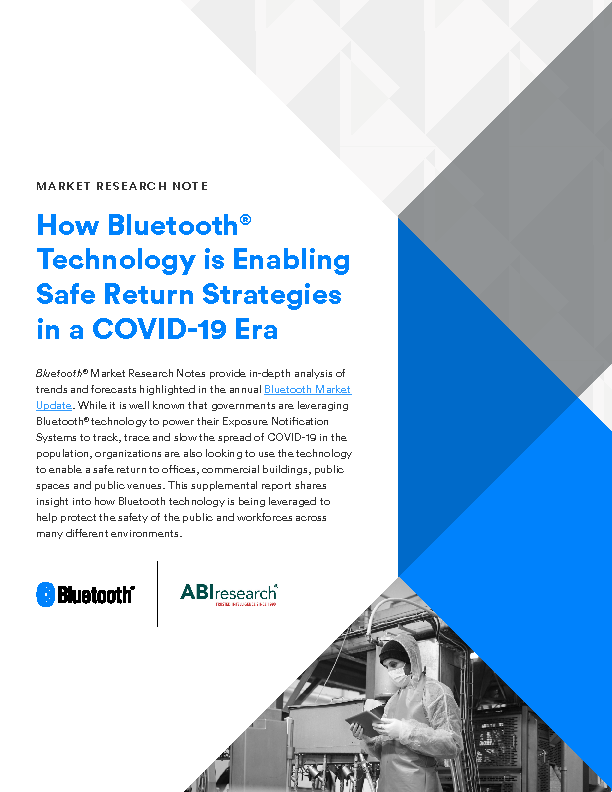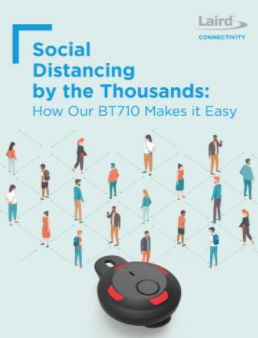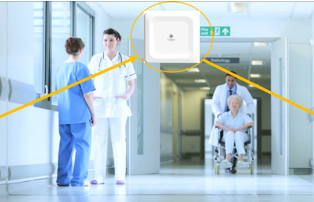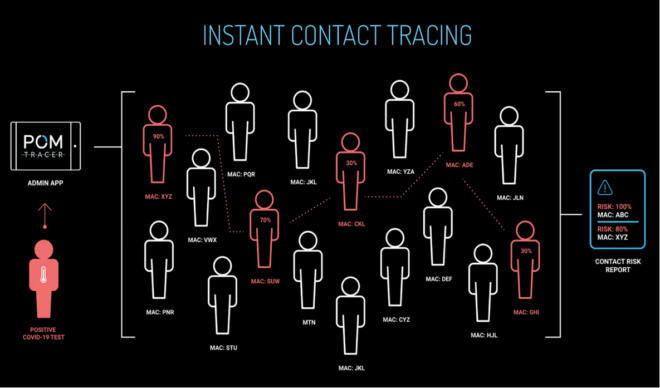The COVID-19 pandemic is transforming the way we work, gather, and live, and the Bluetooth® member community is doing its part to confront the challenges of our new normal and help pave the road to recovery.
Offices, factories, schools, stadiums, and other large venues around the world are looking to Bluetooth® technology to power safe return solutions to help them take every reasonable precaution to reopen or continue to operate safely in this new reality. A recent survey from Envoy and Wakefield Research indicated that 94% of employees would like to spend at least one day a week in the office, yet 73% fear going in. Employers are responding by investing in health response infrastructures that are keeping employees and visitors safe while ensuring business continuity. According to ABI Research, Bluetooth® RTLS deployments in manufacturing, warehousing, and logistics environments will quadruple between 2020 and 2025. Though focused in the short term on spread management and employee health, these deployments also hold the potential to enable additional smart building applications over time that generate efficiencies and ROI in the post-COVID-19 world.
“Bluetooth® technology is the go-to choice for solutions aimed at facilitating the reopening of public venues for a number of reasons. Bluetooth technology’s unique combination of capabilities helps it to deliver a value proposition unmatched by any other medium — open standards, low energy, low cost, and very wide adaptation.”
– Rom Eizenberg, CRO, Kontakt.io
Bluetooth safe return solutions fall within four primary categories: occupancy management, sanitation and hygiene management, exposure management, and touchless access and control.
Occupancy Management
Bluetooth® technology has been rapidly adopted in a variety of occupancy management solutions designed to help prevent the spread of COVID-19 in the facility by enabling building managers to more closely monitor and control the number of occupants at any given time in any given area. Key occupancy management solutions include safe occupancy, safe distancing, and safe routing.
Bluetooth® occupancy sensors are anticipated to grow at a CAGR of 110% between 2020 and 2026, reaching 6 million annual shipments by 2026.
– ABI Research
Safe Occupancy
Compliance with maximum total and zonal density thresholds is critical to protecting the health and safety of building occupants. Facilities can use Bluetooth technology to measure congestion at the building level and monitor occupancy counts in specific zones to prevent overcrowding and establish appropriate scheduling and workflow practices.
Safe Distancing
Bluetooth® technology is being used to help building occupants adhere to social distancing requirements for indoor environments. Bluetooth enabled proximity warnings remind employees and visitors to maintain safe distances to reduce the risk of viral transmission.
Safe Routing
Building managers and employers are deploying Bluetooth wayfinding applications and visitor-flow monitoring solutions to guide workers and visitors through the building using the safest routes and understand movement patterns to identify potential high-risk areas and avoid congestion before it happens.
Hygiene Management
Facilities are leveraging Bluetooth® technology to meet increased building sanitization requirements and enforce hygiene compliance to minimize the risk of transmission in the building. Use-based sanitization solutions help ensure that shared resources such as tools and hot desks and common areas such as kitchens and conference rooms are disinfected in a more timely and efficient manner, keeping occupants healthy while also helping facilities prioritize cleaning resources and manage the cost of complying with new levels of cleanliness.
Exposure Management
Bluetooth® technology is helping enterprises and schools respond quickly and confidently in the case of infection, enabling them to make intelligent decisions on preventive measures without resorting to building-wide shutdowns. Bluetooth health monitoring applications are enabling early, precautionary isolation measures while Bluetooth digital contact tracing solutions are helping break the chain of transmission and ensure business continuity even in the event of confirmed COVID-19 cases.
Health Monitoring
Early detection is key to containing the spread of COVID-19, and, in most enterprise environments, manual monitoring of vitals is not a practical solution. Bluetooth® health monitoring solutions that leverage wearables to track temperature, heart rate, respiratory rate, and other biometric measurements are replacing time-consuming and labor-intensive manual measurement to aid in the prevention and control of COVID-19 infection. These solutions enable real-time monitoring of vital signs to identify individuals experiencing symptoms that correlate with the illness and trigger prompt warnings to ensure precautionary measures are taken in a timely manner. A record of when exactly vital measurements changed can also be kept, making it easier to conduct accurate tracking of close contacts after a potential infection.
Digital Contact Tracing
Public Exposure Notification Systems (ENS) — as well as private, digital contact-tracing solutions powered by Bluetooth® technology — are playing a critical role in containing the spread of COVID-19. By notifying people who have come in contact with an infected individual, determining the length of those interactions, and preserving anonymity throughout the process, ENS and digital contact-tracing solutions help ensure that enterprises and individuals can take the appropriate measures to minimize further spread without compromising employee privacy. Each notification allows employers to react quickly to protect their staff and keep their business operational.
“Bluetooth® technology is the best solution available today for contact tracing and other safe-return solutions. It is reliable, easy to deploy, data privacy friendly, and available on 100% of smartphones worldwide. It is no wonder Apple and Google also chose Bluetooth technology for their contact tracing API and we fully agree.”
– Ege Akpinar, CEO, Pointr
Touchless Access and Control
Door handles and surfaces, keypads, light switches, and other potential shared touchpoints at high-traffic access points in a building have the potential to increase the spread of a communicable disease. Bluetooth® access control solutions leverage Bluetooth badges or smartphone-based entry systems to provide contactless building access that can help reduce the risk of infection and decrease the spread of the virus. To further reduce potential contamination, Bluetooth connected luminaires can be controlled by smartphones without the need to touch a physical light switch.
By 2026, there will be nearly 16 million annual shipments of Bluetooth® access control reader and field panels, resulting in a 102% CAGR between 2021 and 2026.
– ABI Research
Learn more about Bluetooth COVID-19 pandemic response solutions and discover other key uses cases that will help pave the road to recovery.
![]()
FEATURED INNOVATION
COVID-19 Pandemic Response Solutions
See what the Bluetooth® community is doing to confront the challenges of our new normal and help pave the road to recovery.



